More than a park for relaxation and sightseeing, Chinese garden also refers to a landscape garden style which has evolved over 3,000 years. A featured Chinese Garden is surrounded by walls and delicately-designed with ponds, rockery, well-arranged plants and assortment of buildings (halls, pavilions, towers, bridges etc.). Intertwined with ancient Chinese philosophy, aesthetics and ideology, the Chinese classical gardens are priceless treasures with architectural culture and natural beauty.
Generally classical gardens in China can be divided into the imperial gardens in north China and the private gardens in south China. The imperial gardens were always built by the emperors of royal families as a shade in the hot summer, like the Summer Palace, Yuanming Garden (now destoryed) and Chengde Summer Palace. In south China, the gardens were usually constructed for private use by the aristocrats and rich businessmen. The garden owners aim to replicate a natural environment on a miniature scale but to be full of life.
There are four most famous gardens in China, also four best gardens by default, namely Summer Palace in Beijing, Chengde Imperial Summer Resort in Hebei, Humble Administrator’s Garden and Lingering Garden in Suzhou. All of them are listed in the UNESCO World Heritages and hold an important position in Chinese architectures.
Built in: 1750 (Qing Dynasty)
Recommended Visiting Time: 3~4 hours
Ticket Fee: 30 RMB (Apr. to Oct.) or 20 RMB (Nov. to Mar.)
Best Time: All the year around
Address: 19 Xin Jian Gong Men Rd, Haidian District, Beijing
Highlights: Renshou Palace, Leshou Palace, Longevity Hill, Kuming Lake, Foxiang Pavilion, Long Corridor, 17-Arch Bridge...
Beijing is a must for a China tour, and the Summer Palace is a must for a Beijing tour. Covering an area nearly 3 square kilometers, the Summer Palace is China’s largest survived landscape garden as well as the best-preserved imperial garden. People honored it as the museum of imperial gardens. It was built in 1750 during Qing Dynasty. In 1998, UNESCO described it as a masterpiece of Chinese landscape garden design and listed in the World Heritage List.
Just as its name implies, the Summer Palace is seasonal retreat for Royalty from the Forbidden City. It can be divided into three parts, court area, living quarters, and leisure area. In court area, you can see many palace building where the Empress Dowager Cixi and Guangxue Emperor dealt with the affairs. In fact, the Summer Palace was the favorite haunt of Empress Cixi, so you can find many attractions involving her story. In the living quarters, there are many majestic palaces, including Leshou Palace, Yulan Palace, Yiyun Palace... It is really a visual feast and enjoyable journey to visit the last area, which contains entertaining, sightseeing and garden part. The Long Corridor, winding along the shore of Kunming Lake, is exquisitely-decorated with scenic paintings on all the ceiling and beans. Make sure that you won’t miss the Marble Boat, which is something extraordinary to behold. It sits in the water as if docked to a pier.
>> 4 Days Classic Beijing Tour
>> 5 Days Beijing Essence Tour with Experience the Real Hutong Life
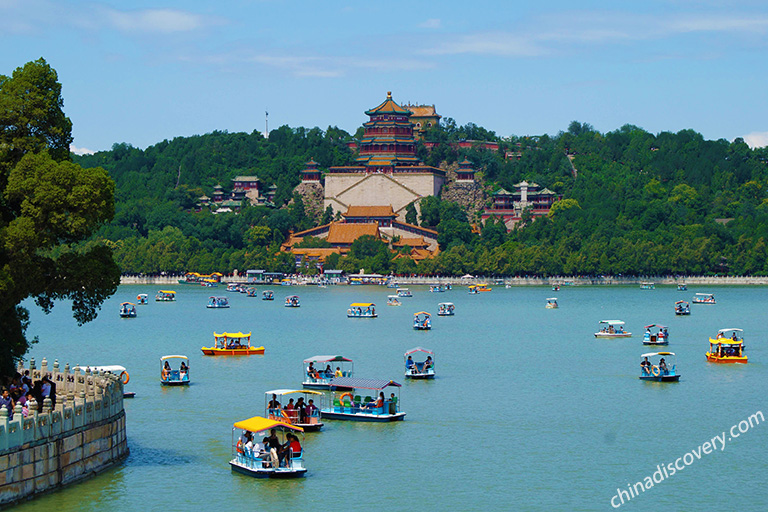 Great Views of Summer Palace
Great Views of Summer Palace
 17-Arch Bridge in the Sunset
17-Arch Bridge in the Sunset
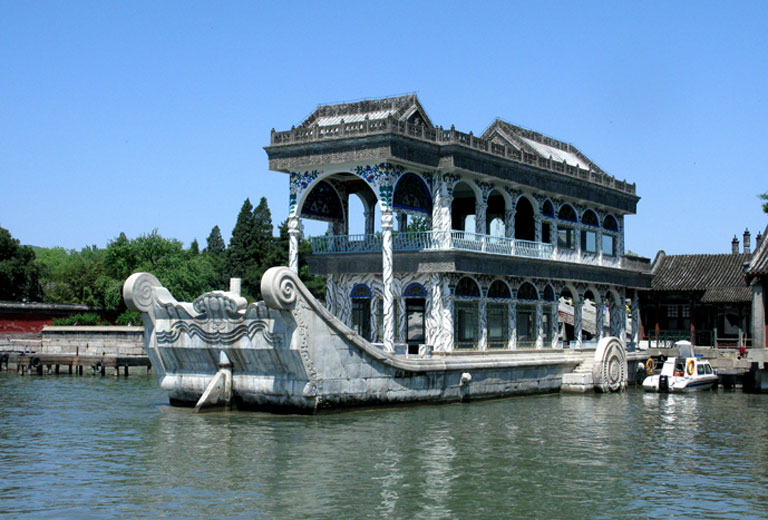 Precious Marble Boate with Delicate Carvings
Precious Marble Boate with Delicate Carvings
Built in: early 16th Century (Ming Dynasty)
Recommended Visiting Time: 2 ~ 3 hours
Ticket Fee: 90 RMB (Apr. ~ Oct.) or 70 RMB (Nov. ~ Mar.)
Best Time: March ~ November
Address: No.178 Northeast Road, Gusu District, Suzhou
Highlights: Drifting Fragrance Hall, Secluded Pavilion of Phoenix Tree and Bamboo, Whom-to-Sit-With Pavilion
Suzhou Classical Gardens are the noteworthy fortunes in the architectural history of China, and they are also the hot theme the works in of the poets and literary men. Among these gardens, Humble Administrator’s Garden is the largest and most prestigious one. Visiting Humble Administrator’s Garden, you can fully appreciate the never-ending superb design from the featured buildings, zigzagging bridges, clean ponds, colorful flowers etc.
There are many distinctive architectures in the Humble Administrator’s Garden imitated by many other gardens, which make it an archetype of imperial gardens. The Drifting Fragrance Hall is featured in the walls with panoptic windows, which offering a wonderful sight of the outside scenery. The Secluded Pavilion of Phoenix Tree and Bamboo is backing against the corridor and confronted with a pond. It shows a strong atmosphere of elegance and quietness. Whom-to-Sit-with Pavilion is an interesting pavilion. From it fan-shaped window, you can see another pavilion which looks like the pattern printed on the fan. Apart from the amazing buildings, you get many other things to do in the Humble Administrator’s Garden, like enjoying colorful flowers during the Azalea Festival (March ~ May) and the Lotus Flower Festival (June ~ October), admiring the delicate Suhou Embroidery show in Millet Fragrance Hall etc.
>> 2 Days Suzhou Classic Garden Tour
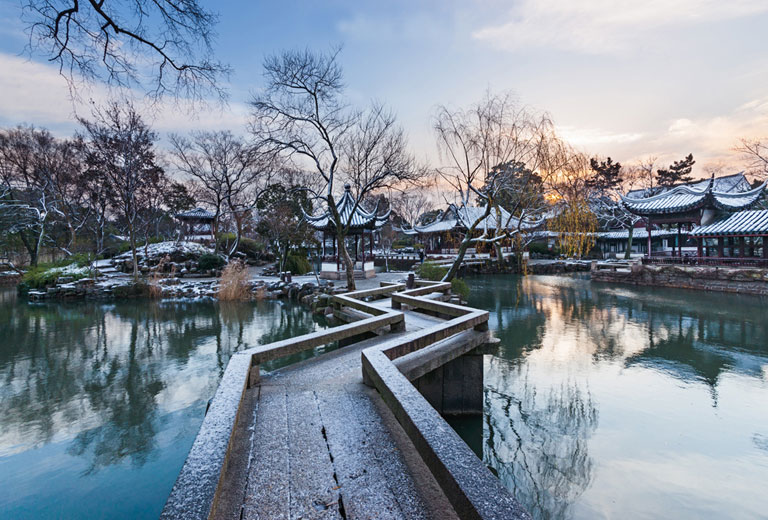 Winding Bridge in the Central Garden (Winter)
Winding Bridge in the Central Garden (Winter)
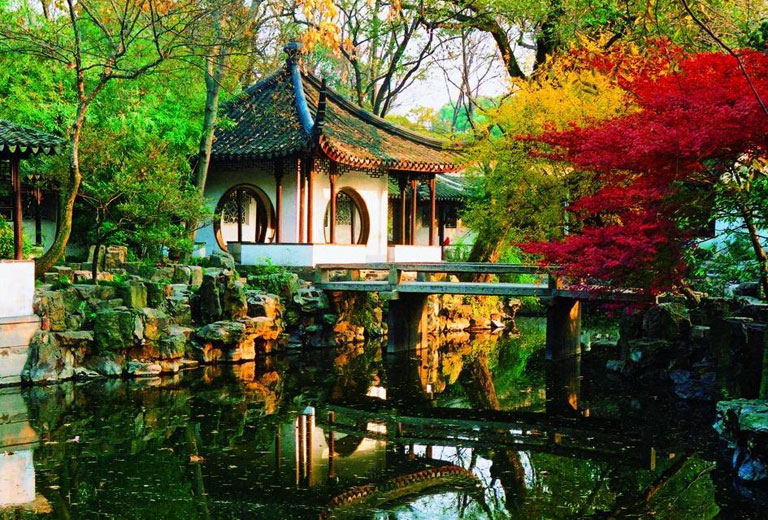 Secluded Pavilion of Phoenix Tree and Bamboo
Secluded Pavilion of Phoenix Tree and Bamboo
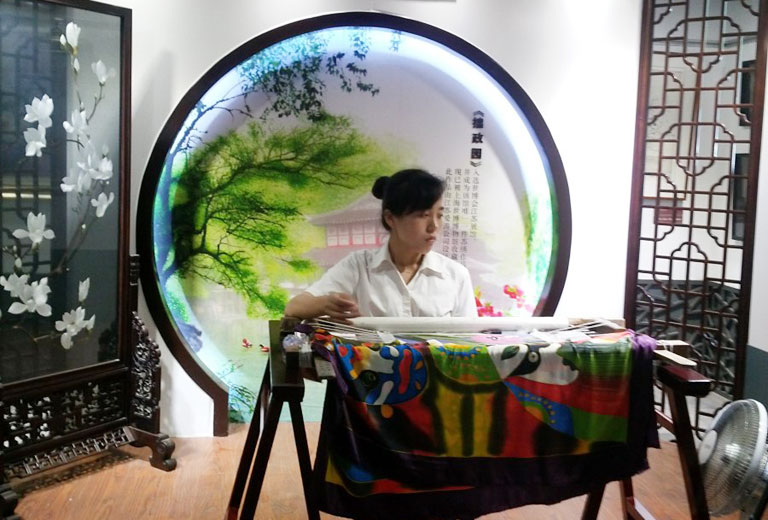 Su Embroidery Performance
Su Embroidery Performance
Built in: 1593 (Ming Dynasty)
Recommended Visiting Time: 2 ~ 3 hours
Tickets: 55 RMB (Apr. ~ Oct.) or 45 RMB (Nov. ~ Mar.)
Best Time: April ~ October
Address: No. 338 Liuyuan Road, Suzhou City, Jiangsu Province
Highlights: Cloud-crowned Peak, Celestial Hall of Five Peaks, Natural Picture of Sunshine after Rain
Unlike the Humble Administrator’s Garden, the Lingering Garden won’t draw your interest at the first sight. The buildings in the garden were not grand usually, but the whole garden creates a poetic and pictorial atmosphere. Though the Linger Garden is much smaller than other three gardens, the design is ingenious as well. In the limited garden, the gardeners are able to build infinite scenes. As you walk in the garden, you can admire the moving pictures with change of light and locations. The varied perforated windows are the highlights of the Lingering Garden. In addition to function of lighting and ventilating, they also act as magical photo frames bringing you the great view.
In the Lingering Gardens, the Three Wonders are a must to visit, including Cloud-crowned Peak, Celestial Hall of Five Peaks and Natural Picture of Sunshine after rain. The Cloud-crowned Peak is a huge Taihu Stone showing slenderness, crinkles, transparency and easiness to penetrate. Honored as the No. 1 Hall in Jiangnan, the Celestial Hall of Five Peaks is the largest hall in the garden. All the beams and columns are made of costly Namu. The Natural Picture of Sunshine after Rain is a natural marble picture, from which you can recognize the mountains, stream, waterfall, clouds, and sun. The Lingering Garden also provides daily opera performance (Kunqu Opera Show, Suzhou Opera Show and Wuxi Opera Show).
>> 2 Days Suzhou Classic Garden Tour
 Picturesque Lingering Garden in Spring
Picturesque Lingering Garden in Spring
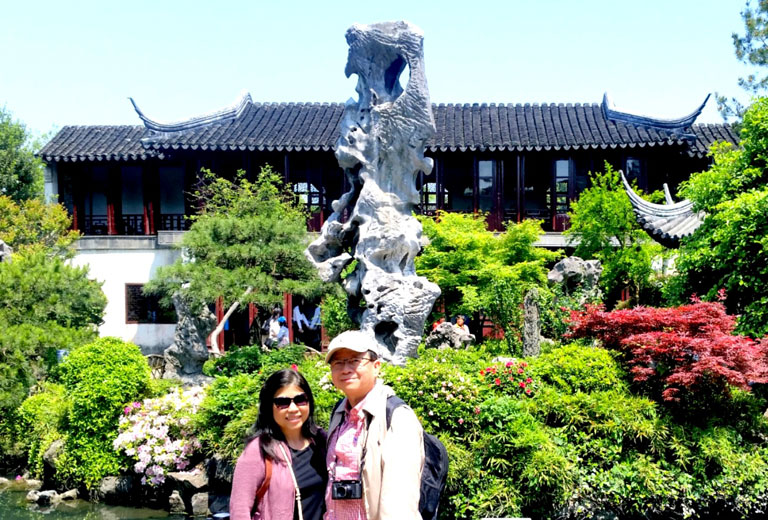 Our Customers Nguyen and Hung Visited Cloud-crowned Peak
Our Customers Nguyen and Hung Visited Cloud-crowned Peak
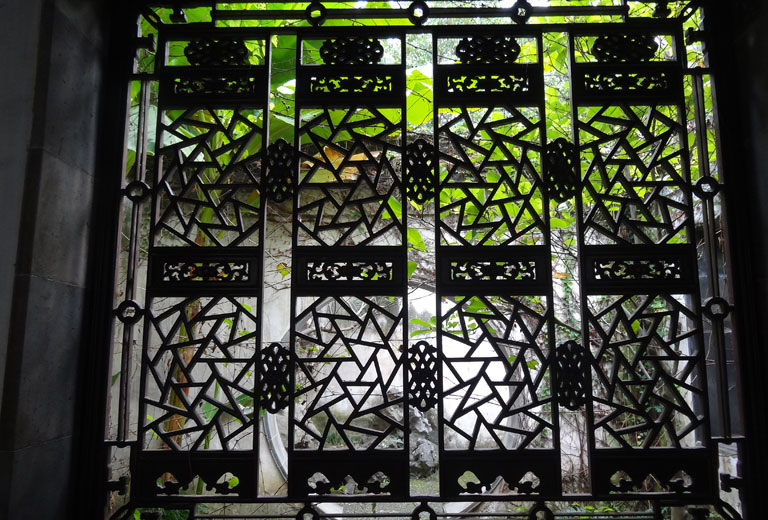 Our Perforated Windows in the Lingering Garden
Our Perforated Windows in the Lingering Garden
Built in: early 1703 (Qing Dynasty)
Recommended Visiting Time: 4~6 hours
Tickets: 145 RMB (Apr. ~ Oct.) or 90 RMB (Nov. ~ Mar.)
Best Time: April ~ October
Address: North of Shuangqiao District, Chengde, Hebei Province
Highlights:Wooden-club Mountain, Puning Temple, Mulan Padock, Eight Outer Temples, Bashang Gransland
Chengde Imperial Summer, also calledChengde Mountain Resort, Resort is a large complex of imperial palaces and gardens located in Chengde of Hebei. Combined with Forbidden City, and Temple of Confucius Temple, it is one of the three largest ancient building groups. It once was the summer palace of the emperors in Qing dynasty. In fact, Chengde Imperial Summer Resort is the epitome of Chinese landscape and landform, with waterscape in southeast, mountain views in northwest and plain area in central parts. It is a milestone in the history of Chinese garden and a great achievement of Chinese classical gardens. Because of its vast and rich collections of Chinese landscape and architecture, the Imperial Summer Resort is regarded as a culmination of all variety of Chinese Gardens.
The garden is made up of Palace Area, Mountain Area, Lake Area and Plain Area. People usually describe Chengde Imperial Summer Resort as “garden in mountain and mountain in garden”. It is also famous for its 72 scenic spots which were named by Kangxi Emperor and Qianlong Emperor. There were Many sports in Chengde Imperial Summer Resorts were copied from many other landscaped gardens or temples. For instance, the Zhijing Yundi is modeled upon of Sudi and Baidi in the West Lake and the famed Potarak Doctrine is a replica of the Potala Palace in Lhasa. As a result, the tourists are able to admire the different garden-styles in only one garden.
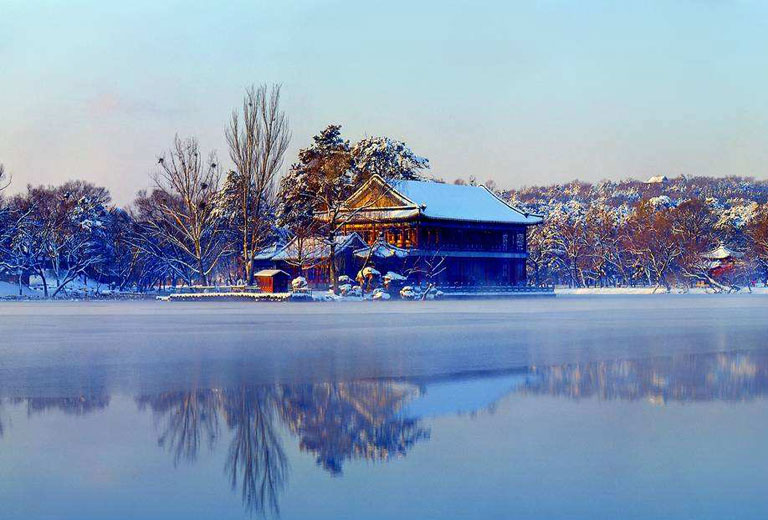 Peaceful Chengde Summer Resort in Winter
Peaceful Chengde Summer Resort in Winter
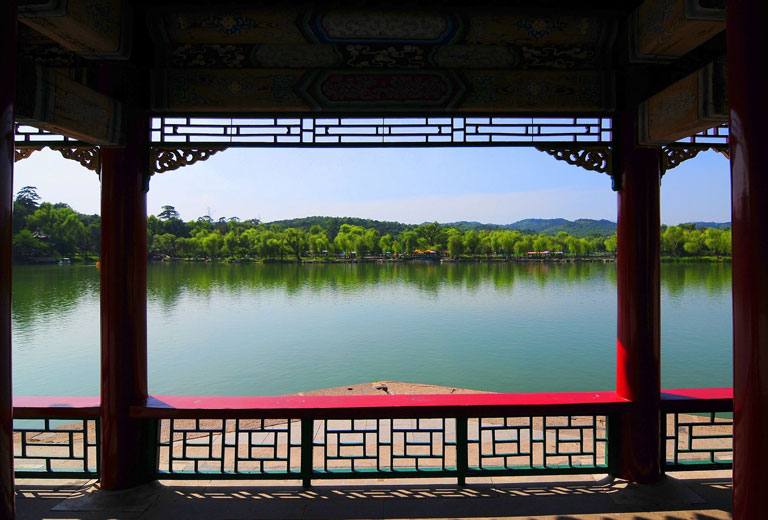 Wonderful Sightseeing from the Relaxing Area
Wonderful Sightseeing from the Relaxing Area
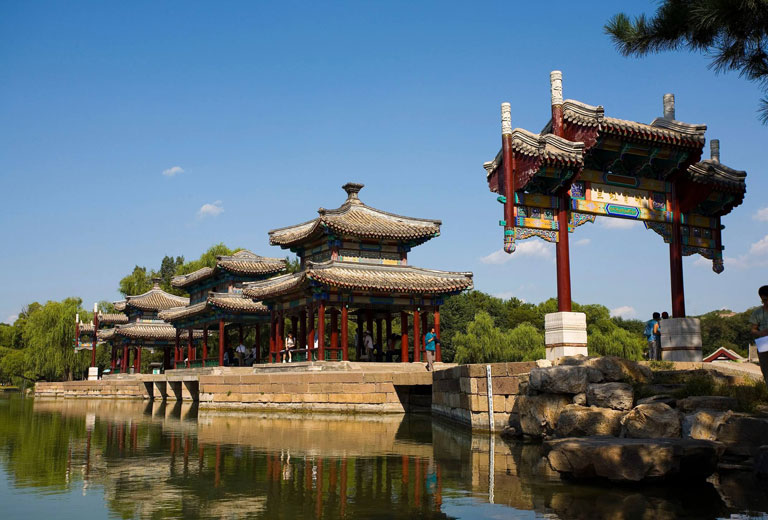 Time-honored Architectures
Time-honored Architectures
Apart from the top 4 gardens, there are many other gardens deserving your visit. The following three gardens are the loved by tourists most.
Yuyuan Garden – Similar to Suzhou Classical Gardens, Yuyuan Garden in Shanghai enjoys a good reputation for its artistic layout. Taking advantage of unique skill combing architecture with the surrounding scenery, the gardeners created Yuyuan Garden that is peaceful heavens away from the world’s turmoil. However, walking out of Yuyuan Garden, you can enjoy the busy bazar, including various shops, popular restuarant, and some other attractions.
Norbulingka Park – Norbulingka Park in Lhasa, once to be the summer palace of Dalai Lama, is a joyous garden for Tibetan people now. In this garden, you can enjoy the Tibetan-style palace. There are over 100 spcies of rare plants from Himalayan grown in the park. In high-altitude Lhasa, Norbulingka is the best place to enjoy the vivid plants. During the Shoton Festival, the local people will gather in Norbulingka to have a picnic and enjoy the Tibetan Opera.
The Master of the Nets Garden – Suzhou classical gardens, which are well-known in recreating natural beauty in miniature, is perfectly illustrated in the Master of the Net Garden. Covering a small area less than 1/6 of the Humble Administrator’s Garden, the Master of the Nets Garden is a compact but ideally-proportioned garden. From May to November, there will be a night garden traditional art performance.
 Beautiful Night View of Yuyuan Garden
Beautiful Night View of Yuyuan Garden
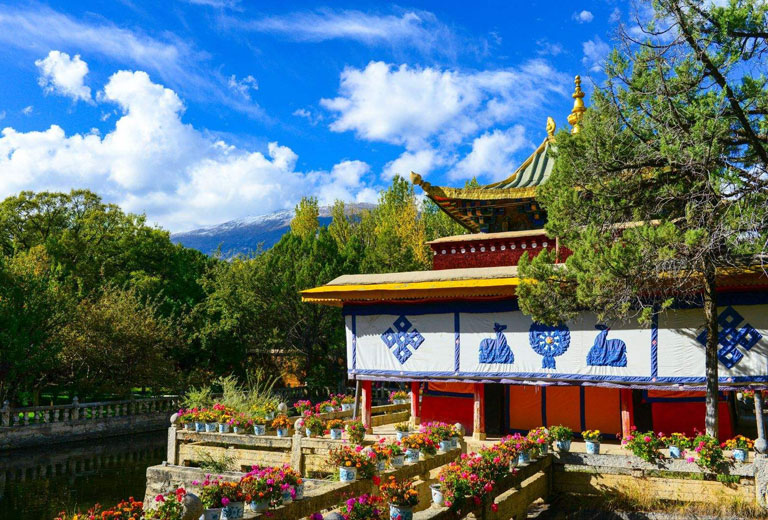 Tibetan-style Building in Norbulingka
Tibetan-style Building in Norbulingka
Are you interested in Chinese classical gardens and do you want to explore the garden art more profound? Just feel free to contact us and our travel consultant will customize a private garden tour for you. All the itinerary and details will be made according to you own needs and interests.
During the tour, you will get rid of the hustle and public transportation and troublesome navigation. Our local guides and drivers will escort you to any attractions with speed and convenience, and take care of you all the time. The professional travel guides can explain you the history and culture of the different gardens, the architectural art, as well as the gardening skills.
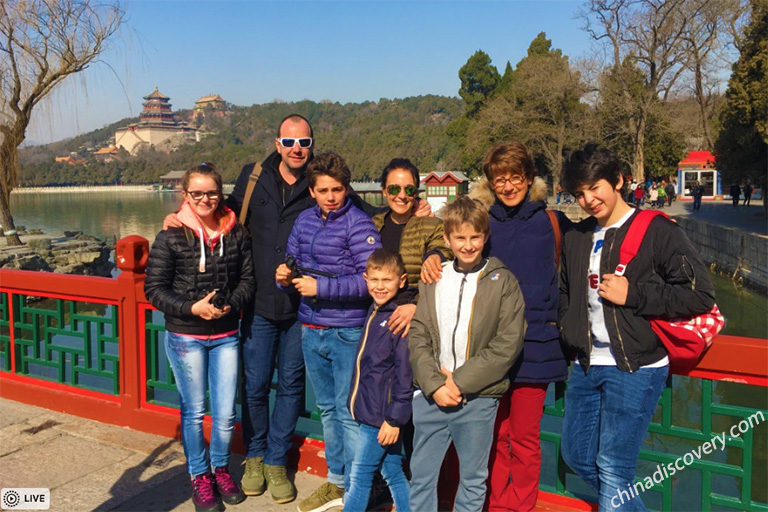 Larissa and her family visited Summer Palace with China Discovery
Larissa and her family visited Summer Palace with China Discovery
Top 3 tours chosen by most customers to explore in the best way. Check the detailed itinerary, or tailor your own trip now with us.
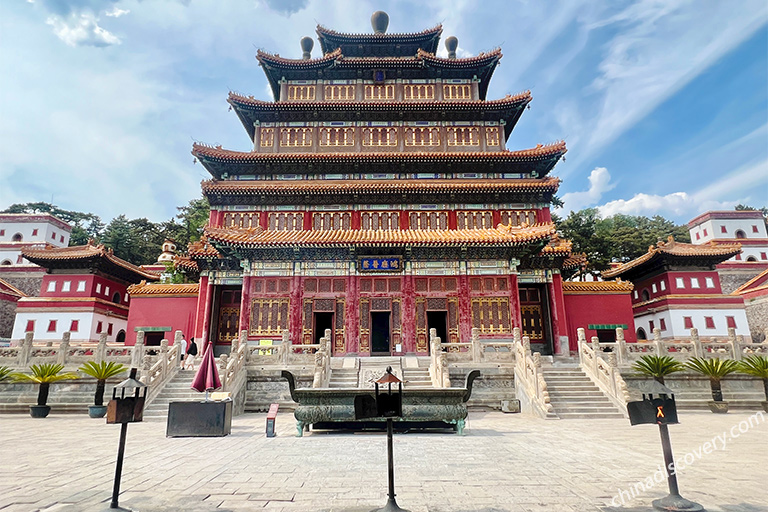
Beijing / Chengde / Beijing
Start planning your tailor-made holiday to China by contacting one of our specialists. Once inquired, you’ll get a response within 0.5~23.5 hours.
Customize a Trip